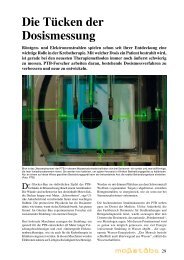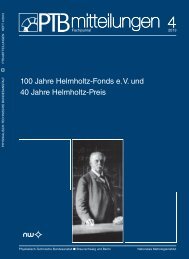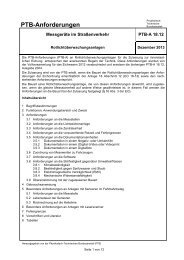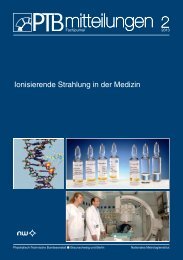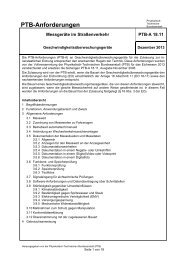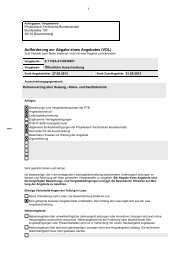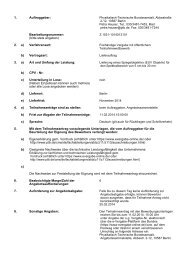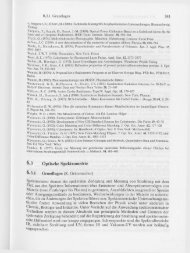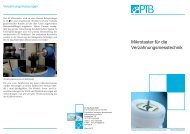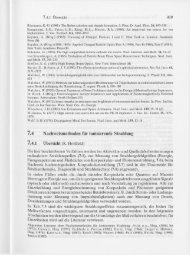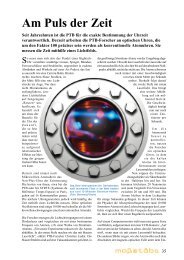PTB-Jahresbericht 2005
PTB-Jahresbericht 2005
PTB-Jahresbericht 2005
Erfolgreiche ePaper selbst erstellen
Machen Sie aus Ihren PDF Publikationen ein blätterbares Flipbook mit unserer einzigartigen Google optimierten e-Paper Software.
Arbeitsgebiete und Ziele • Fields of work and objectives<br />
Grundlagen der Metrologie<br />
Der Bereich „Grundlagen der Metrologie“<br />
umfasst die in der Satzung verankerten Arbeiten<br />
zur Darstellung und Weitergabe der SI-<br />
Einheiten und der gesetzlichen Zeit. Hierzu<br />
gehören insbesondere die Entwicklung und<br />
Bereitstellung von Primärnormalen und<br />
Normalmesseinrichtungen und der gegebenenfalls<br />
für die Weitergabe der Einheiten<br />
benötigten Sekundär- und Transfernormale.<br />
Mission ist „die Schaffung des Fundaments<br />
für das nationale Messwesen, das den heutigen<br />
und für die Zukunft absehbaren Anforderungen<br />
genügt“.<br />
Eine besondere Herausforderung stellen die<br />
Arbeiten zur Rückführung von SI-Einheiten<br />
auf Fundamentalkonstanten dar, wie dies für<br />
Sekunde, Meter, Volt und Ohm bereits gelungen<br />
ist, da man – zumindest nach unserem<br />
heutigen Verständnis der Physik – dann von<br />
einer von Ort und Zeit unabhängigen Realisierung<br />
der jeweiligen Einheit ausgehen kann.<br />
Durch den Beschluss des Comité International<br />
des Poids et Mesures (CIPM), vorbereitende<br />
Maßnahmen zur Neudefinition der Einheiten<br />
Ampere, Kelvin, Kilogramm und Mol auf der<br />
Basis von Fundamentalkonstanten einzuleiten,<br />
haben diese Arbeiten zusätzlich an Aktualität<br />
und Bedeutung gewonnen. Aber auch<br />
bei der Darstellung von Einheiten auf der<br />
Basis klassischer Prinzipien, z. B. für die<br />
dimensionelle Messtechnik, steigen die Anforderungen<br />
an die tolerierbaren Unsicherheiten<br />
stetig, so dass Technologien verbessert bzw.<br />
neu entwickelt und genutzt werden müssen.<br />
Zunehmende Bedeutung gewinnt die Rückführung<br />
von Messungen in der analytischen<br />
und speziell klinischen Chemie auf international<br />
anerkannte Normale oder Normalmesseinrichtungen,<br />
die für ausgewählte organische<br />
und anorganische Analyte in der <strong>PTB</strong><br />
und ihren Kooperationspartnern (BAM, UBA,<br />
DGKL) entwickelt bzw. betrieben werden.<br />
Von besonderer gesellschaftlicher Bedeutung<br />
ist die Entwicklung von Normalen und Normalmesseinrichtungen<br />
für die medizinische<br />
Diagnostik und Therapiekontrolle, beispielsweise<br />
für die Dosimetrie ionisierender Strahlung,<br />
die Ultraschall-Diagnostik oder optische,<br />
bioelektrische, biomagnetische und<br />
NMR-Diagnoseverfahren.<br />
Insbesondere aus Sicht moderner Fertigungstechnik<br />
gewinnt das Gebiet der Nanometro-<br />
8<br />
Fundamentals of Metrology<br />
The area “Fundamentals of metrology” covers<br />
the work as defined in the Statutes for the<br />
realization and dissemination of the SI units<br />
and of legal time. These activities encompass<br />
in particular the development and provision<br />
of primary standards and standard measuring<br />
devices as well as of the secondary and transfer<br />
standards needed for the dissemination of<br />
the units. The mission is “the provision of the<br />
foundation for the national metrology system,<br />
which meets the present and foreseeable<br />
future requirements”.<br />
Especially challenging is the task to provide<br />
traceability of the SI units to fundamental<br />
constants, as has already succeeded for the<br />
second, the metre, the volt and the ohm,<br />
because, at least to our present understanding<br />
of physics, it can then be assumed that the<br />
individual units have been realized independently<br />
of location and time. The decision of the<br />
Comité International des Poids et Mesures<br />
(CIPM) to initiate preparatory measures for<br />
the redefinition of the units ampere, kelvin,<br />
kilogram and mole on the basis of natural<br />
constants has conferred additional topicality<br />
and importance to these activities. But also for<br />
the realization of units on the basis of classical<br />
principles, e.g. for dimensional metrology, the<br />
requirements for tolerable uncertainties<br />
increase permanently so that the existing<br />
technologies must be improved or new technologies<br />
be developed. Of increasing importance<br />
is the traceability of measurements in<br />
analytical and especially in clinical chemistry<br />
to internationally recognized standards or<br />
standard measuring devices developed and<br />
operated at the <strong>PTB</strong> and by its cooperation<br />
partners (BAM, UBA, DGKL) for selected<br />
organic and anorganic analytes. Of particular<br />
importance to society is the development of<br />
standards and standard measuring devices<br />
for medical diagnostics and therapy followup,<br />
for example for the dosimetry of ionizing<br />
radiation, ultrasound diagnostics or optical,<br />
bioelectric, biomagnetic and NMR diagnostic<br />
methods.<br />
Especially for modern production engineering,<br />
the field of nanometrology increasingly<br />
gains in importance, encompassing not only<br />
the quantitative dimensional determination of<br />
micro or nanostructures with a resolution in<br />
the range of a few atomic diameters but also



